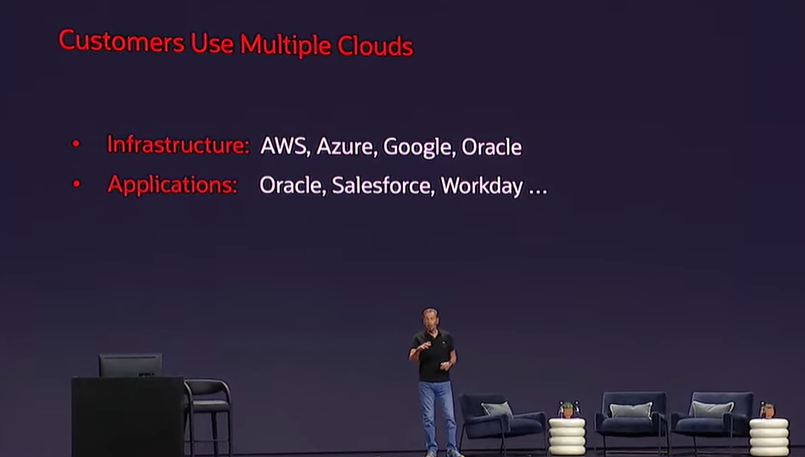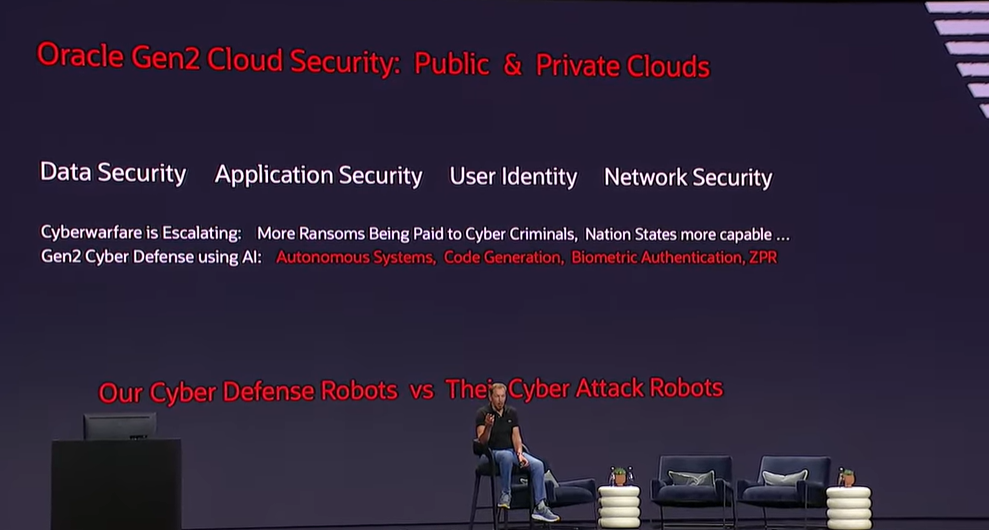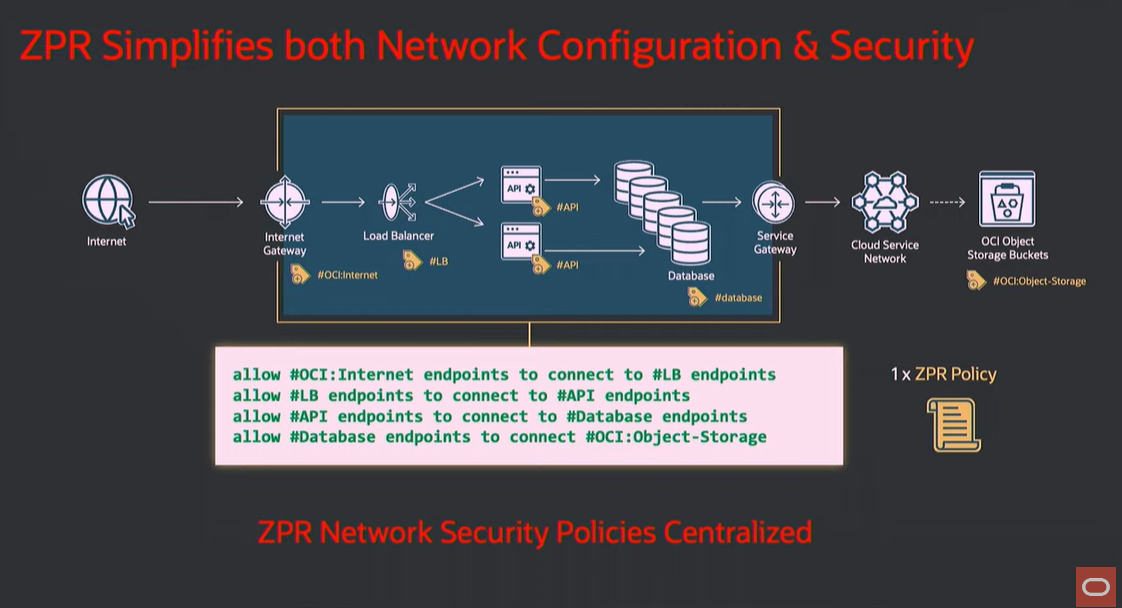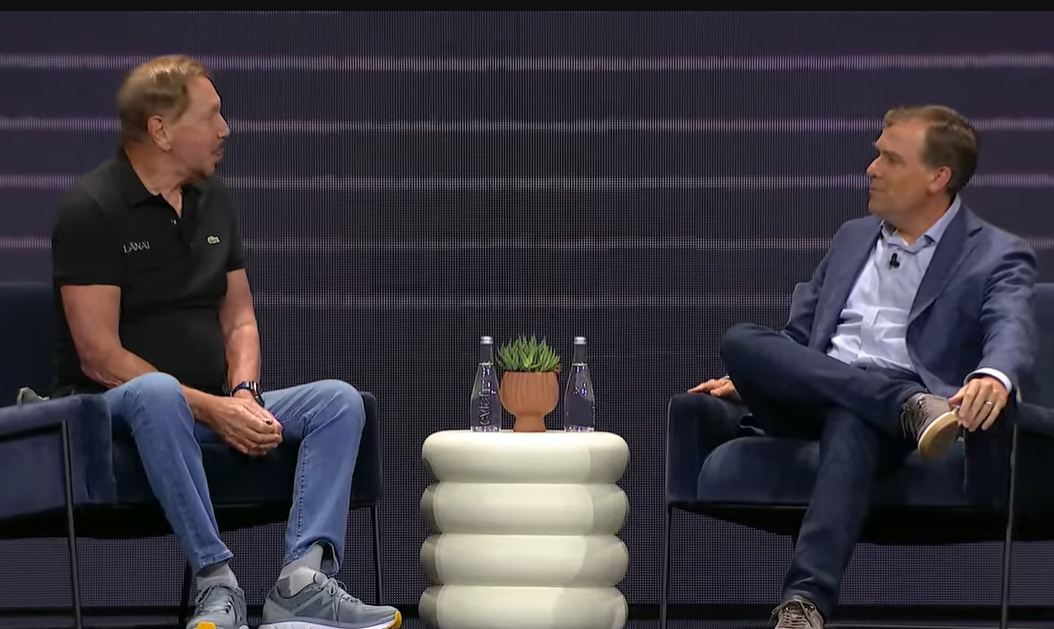Oracle CTO Larry Ellison hit the stage with AWS CEO Matt Garman to talk about their multicloud partnership and optimizing. Ellison also talked about Oracle's autonomous security efforts to prevent ransomware, identity theft and other attacks.
Speaking during his Oracle CloudWorld keynote, Ellison followed up the AWS announcement with a few more details and a lot of strategy for Oracle. His main argument is that seamless multicloud technology is happening now.
"We lost the idea that customers could buy technology from many different companies, and those technologies work gracefully together and we're entering a new phase where services on different clouds work gracefully together," said Ellison. "The clouds are becoming open. They're no longer walled gardens, but customers will have choices and can use multiple clouds together."
Garman said Oracle and AWS have multiple joint customers. He said:
"We'll take an example of somebody like a Best Buy, who runs many of their systems inside of AWS. Best Buy has recommendations for their customers and lots of interesting e commerce applications, and they run their core database workloads on Oracle. This is a great solution for them."
Garman said that the integration between AWS and Oracle will result in a native experience to the point where Oracle database backs up to AWS S3. The prices through Oracle Cloud and AWS are the same for databases.
Ellison added:
"We think this (Oracle and AWS) dramatically expands the market. It's what customers have asked for very long time. My friend Jamie Dimon has got huge commitments at JPMorgan Chase. Every time he saw he asked when we are going to have AWS. Now I finally have an answer."
State Street CTO Andy Zitney said the deal will be a big gain for the company, a big Oracle Exadata and AWS customer. "we were starting down the journey of starting to integrate the clouds, and this comes right at the perfect time to expedite that and make it easier for us," said Zitney. "It will help us accelerate our digital transformation."

AWS and Oracle's first region will be in Virginia, but Zitney noted that State Street needs global coverage and can prioritize locations. Zitney said State Street's current footprint with AWS is 43, but the plan is to scale that down. "We're thinking the number will be 30 to 40 in the end," said Zitney. "With this I won't need on-prem as much as I used to."
Ellison added that Oracle's multicloud strategy doesn't end with AWS, Microsoft Azure and Google Cloud. He noted that Oracle embeds its database services in Fujitsu as well as NTT.
"The interesting thing about this multicloud world is whichever is your primary cloud you can reach out to other clouds, infrastructure, and mix and match the applications and the services you want," said Ellison.
Cyber defense robots
Ellison's other big topic was cybersecurity.
"Oracle is using AI to build cyber defense robots and autonomous systems to defend against identity theft," said Ellison. "We are using AI to prevent that from happening. We can use AI to dramatically improve cloud security. The cyberwars are getting worse not better."
Ellison said the CIA was among Oracle's first customers and data security is critical. "We look at four pillars of security at Oracle. One is data security. Make sure under no circumstance can people steal, look at your data, steal your data, or lock you out and away from your own data. We have to have absolute data security," he said.
Ellison also added that Oracle's other pillars for security are application and network security.

The pitch from Ellison is that cybersecurity systems need to be autonomous. "what we need to do is a set of cyber robots, defense robots to stop these attacks," he said. "We can do a better job of protecting our data if the database system that is managing that data is fully autonomous. And this is something that Oracle has been working on for a very long time."
Like most cybersecurity experts, Ellison said human error is largely to blame for many attacks. Autonomous systems are simply safer.
As a result, Oracle is moving all of its applications to Autonomous Database by 2025. "No human labor, no human error. It's really interesting that it is the most economical way to do things and the safest way to do things," said Ellison. "We're moving not to save money, but to secure data better."
Other security takeaways from Ellison:
- Biometric security needed. Oracle won't have any passwords in the future because biometrics will replace them. Ellison added that biometric databases have multiple use cases especially credit cards. Passport control, secure school entry and prescription pickups are also good use cases for biometric security.
- Autonomous code generation will also be more secure. "When the application generator generates the code, we don't generate security vulnerabilities. We don't we don't generate security vulnerabilities. A computer program is writing the code, it will not make that mistake," he said.
- Zero Trust Packet Routing (ZPR) is another pillar. "The solution to the problem is you really have to separate network security from network configuration," said Ellison, who noted that ZPR is being rolled out in Oracle Cloud.
"Let's build an all new system that's responsible for network security and that all new, that all new system will authorize certain paths through the network for certain users to use certain services, look at certain data, and only authorized pads are allowed. No other paths will be allowed. It's a brand new network security system that is separate from network configuration, rather than blended with network configuration."
Robots are designed to inspect every packet every second, he added.




